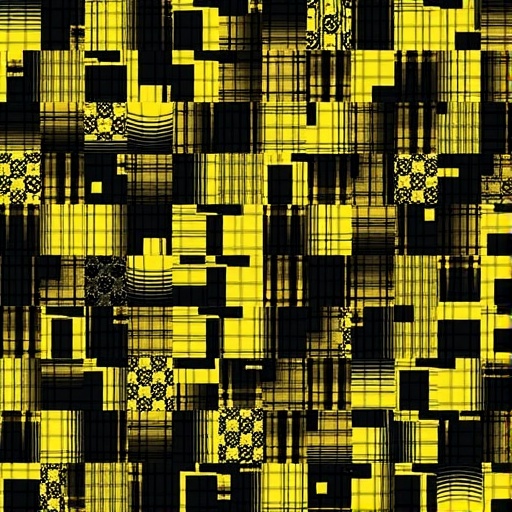In a groundbreaking advancement that promises to redefine the landscape of optoelectronic devices, recent research has unveiled substantial progress in the patterning of perovskite films specifically tailored for photodetector applications. Perovskite materials have long captivated the scientific community due to their exceptional optoelectronic properties, including high absorption coefficients, tunable bandgaps, and remarkable charge carrier mobilities. The latest study by Hu, Li, Wang, and colleagues dives deep into the sophisticated methodologies that enable precise spatial control over perovskite film morphologies, thereby opening new avenues for enhancing photodetector performance.
Perovskite photodetectors stand at the forefront of next-generation sensing technology due to their low-cost fabrication, lightweight structure, and scalability. However, one of the prevailing challenges has been the ability to effectively pattern these films at micro- and nanoscale resolutions without compromising their intrinsic optoelectronic properties. This limitation has hindered device integration and miniaturization, essential for high-density photonic circuits. The researchers have methodically explored state-of-the-art patterning techniques that encompass a spectrum of physical and chemical approaches, laying the groundwork for unprecedented device architectures.
Among the pivotal techniques highlighted, photolithography continues to be a cornerstone, albeit with adaptations to accommodate the sensitivity of perovskite materials to solvents and radiation. The research underscores innovations such as solvent-free patterning routes and the adoption of orthogonal chemistries that sidestep traditional photolithographic limitations. These approaches ensure the preservation of perovskite crystallinity and optoelectronic integrity, which are vital for photodetector efficiency.
In parallel, nanoimprint lithography emerges as a compelling alternative, offering sub-100-nanometer resolution with minimal damage to the perovskite films. The mechanical stamping process imprints high-fidelity patterns directly onto the films, facilitating enhanced light-matter interaction through engineered nanostructures. This method’s compatibility with roll-to-roll manufacturing also underlines its potential for large-scale production, bridging the gap between laboratory-scale innovation and commercial viability.
Inkjet and spray printing techniques have garnered attention for their versatility in patterning perovskite films, especially for flexible substrates. By optimizing ink formulations and deposition parameters, the study reveals how high-resolution patterns can be achieved without detrimental effects on film uniformity or electronic characteristics. This is particularly advantageous for wearable photodetectors and integrated optoelectronic systems where conformability and lightweight design are paramount.
Chemical patterning, leveraging self-assembled monolayers and selective surface functionalization, introduces another layer of sophistication. These methods allow for spatially defined nucleation and growth of perovskite crystals, leading to ordered arrays of micro- or nanostructures. Such precision in crystal engineering directly correlates with superior photodetector responsiveness and noise reduction by minimizing defect states and enhancing charge carrier pathways.
Moreover, the study emphasizes laser-assisted patterning techniques, which utilize ultrafast laser pulses to induce localized crystallization or ablation. This contactless method affords high spatial resolution and the ability to create intricate patterns without chemical contamination. The laser parameters can be finely tuned to manipulate film morphology, enabling custom-designed photodetector arrays optimized for specific spectral sensitivities.
A crucial aspect addressed is the stability of patterned perovskite films under operational conditions. The researchers report advances in encapsulation strategies and compositional engineering that mitigate environmental degradation. The integration of patterning processes with stability-enhancing treatments ensures that the photodetectors maintain their performance over extended durations, a fundamental requirement for real-world applications ranging from imaging to environmental monitoring.
Importantly, the interplay between pattern geometry and device architecture is explored in detail. Through simulation and empirical studies, the paper demonstrates how periodic nanostructures influence light trapping, carrier diffusion, and photoconductive gain. Customizable patterns allow designers to tailor photodetector characteristics such as responsivity, detection bandwidth, and noise equivalent power according to application-specific demands.
The collective advances in perovskite film patterning unlock transformative potential for multifunctional photodetector arrays, including hyperspectral imaging and polarization-sensitive detection. The ability to integrate diverse functionalities on a single chip without compromising device density or performance heralds a new era of compact, efficient, and high-speed photonic systems.
Inherent challenges remain, particularly in scaling these patterning techniques while maintaining uniformity and minimizing defects. The paper calls for continued interdisciplinary efforts combining materials science, chemistry, and nanofabrication to refine patterning processes compatible with industrial manufacturing workflows.
Furthermore, the research delves into the mechanistic understanding of nucleation and growth dynamics under patterned conditions, providing theoretical insights that inform process optimization. This fundamental knowledge serves as a foundation for deliberate design choices that enhance the reproducibility and scalability of patterned perovskite photodetectors.
The study’s implications extend beyond photodetection, potentially impacting the broader arena of perovskite-based optoelectronics, including light-emitting devices and solar cells. The versatility of the described patterning strategies could catalyze innovations across diverse platforms, fostering the integration of perovskite materials into mainstream technology.
In conclusion, this comprehensive review captures the state-of-the-art in perovskite film patterning for photodetectors, highlighting the synergy between innovative fabrication techniques and novel material engineering. As this field accelerates, it promises to deliver photodetector devices with unprecedented sensitivity, speed, and functionality, poised to revolutionize sensing technologies across scientific and commercial domains.
Subject of Research: Patterning of perovskite films to enhance photodetector performance.
Article Title: Recent progress in the patterning of perovskite films for photodetector applications.
Article References:
Hu, C., Li, B., Wang, X. et al. Recent progress in the patterning of perovskite films for photodetector applications. Light Sci Appl 14, 355 (2025). https://doi.org/10.1038/s41377-025-01958-z
Image Credits: AI Generated
DOI: https://doi.org/10.1038/s41377-025-01958-z
Tags: advancements in photodetector technologydevice integration in photonicsenhanced photodetector performancehigh-density photonic circuitslow-cost optoelectronic devicesmicro-nanoscale film fabricationoptoelectronic properties of perovskitespatterning challenges in perovskite materialsperovskite film patterning techniquesscalable perovskite photodetectorssolvent-free patterning innovationsstate-of-the-art patterning methodologies





